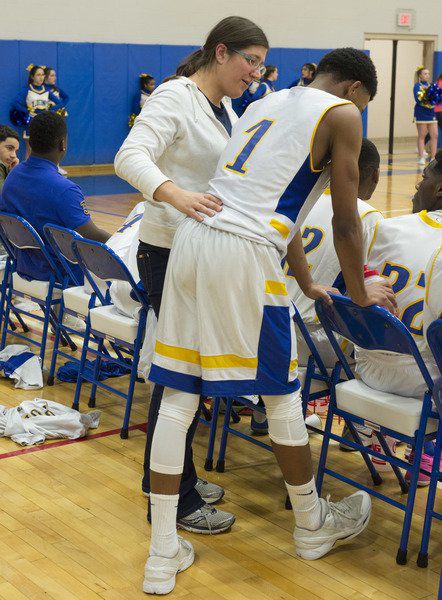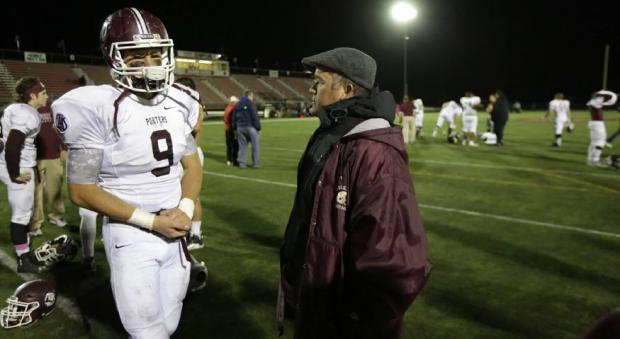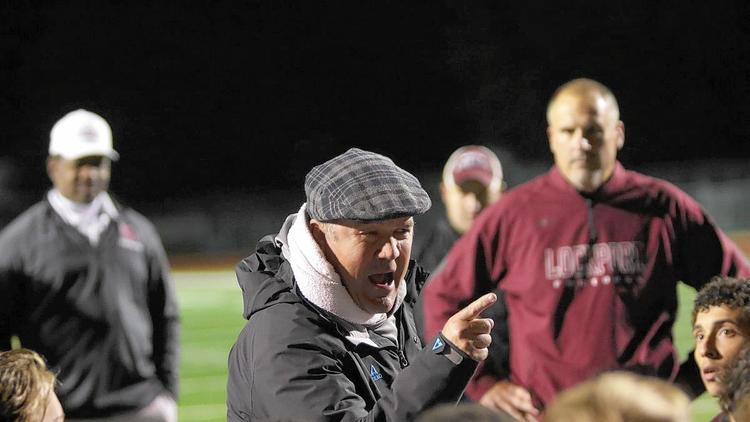
Article reposted from Lockport Union Sun & Journal
Author: JOHN D’ONOFRIO
A Niagara Falls wrestler laid still on the mat in Lockport’s gymnasium last week, while his Lockport opponent rose abruptly and backed slowly away.
Something was wrong.
Suddenly, from off to the side, Lockport athletics trainer Rosalyn “Rosie” Heinemann moved in quickly, knelt in front of the injured grappler and addressed the medical situation. After determining that the Wolverines grappler’s shoulder was out of place, Heinemann popped the shoulder back in carefully, professionally, and with little fanfare.
Moments later, the wrestler was up off the mat and the match between the rival schools continued.
For Heinemann, it was just another day at the office. For the high school student-athletes of today, it’s a completely different — albeit much safer — sports environment than the one their parents and grandparents grew up in.
Today’s certified athletic trainer is a far cry from what was available on site for high school student athletes a half century ago. Local ATs like Heinemann are not employees of the districts they serve, but rather, are employed by companies that are contracted by the districts. With ever increasing protocols to follow today, especially regarding head injuries, and the legal ramifications of the work they do and split-second decisions they must sometimes make, today’s trainers are the heart and soul of contemporary medical field in school districts throughout the country.
Schools Superintendent Michelle Bradley said Lockport first opted to begin contracting out for AT services about 15 years ago. She cited the expertise, experience and speed in which first responders provide to a medical situation, and the freedom an AT gives coaching staffs to concentrate more on practices and games. Coaches work closely with athletic trainers and count heavily on their advise and diagnosis when dealing with both an injured player and their concerned parents.
A team response
Imagine the shock of seeing your son or daughter falling down injured in the middle of a high school sports contest.
If this were two decades ago, you would have waited anxiously for teammates to help carry him or her off the field, done your inexperienced best to diagnose the injury and then driven them to a local hospital or their personal doctor for additional treatment if needed.
Today, usually within seconds, injured student athletes fall under the care of a trained first responder, like Heinemann, who are connected via radio with a certified physician on call. An initial diagnosis is conducted within seconds and steps are implemented immediately to treat the injury. In cases of extreme distress, an ambulance is summoned and the athlete is rushed to a local hospital that is notified ahead of time of the pending patient and type of injury.
From Band-Aids to concussions, times have changed for the better.
Today’s high school athletic trainers mirror the teams they cover with respect to the depth and scope of their organizations. It’s a team approach with players and coaches on the field, obviously, but it’s an equally important collaboration off the field, with each individual medical response component contributing to a more timely diagnosis and treatment of injured student athletes than ever before.
Heinemann, along with fellow ATs in this area at Barker, Newfane, Roy-Hart, Starpoint and Wilson high schools, are one giant extension of a larger team that includes a physician on call at all times and a group of certified, highly-skilled, highly-competent first responders who do more than simply wrap you in bandages and ice packs.
“Her responsibilities are pretty much involved with all sports that the school offers,” said LHS athletics director Todd Sukdolak. “With Rosie, knowing how well she knows the kids, I would give her a 99.99 percent accuracy rate. She’s very knowledgeable in her field.”
Athletic trainers today like Heinemann, Lockport’s designated athletic trainer for the past nine years, must attend Board of Certification (BOC)-approved schools and pass not only a series of complicated written tests, but hands-on assessment testing as well. The assessments involve a variety of potential injury situations to demonstrate how they would handle it.
Heinemann, the daughter of Jim and Lois Ganschow of North Tonawanda, said the two keys to longevity today in her specialized field of work is loving what you do and earning the trust of the student athletes assigned to you.
“I grew up in a very medical family — my mom’s a nurse, my older sister’s a doctor and my other sister’s a physical therapist,” said Heinemann, a former star Lumberjacks athlete at North Tonawanda High School.
“I hurt my ankle once at a Kenmore West basketball game and they took me out of the game and the trainers looked me over and iced me. That was the moment in my life where something went off in my head and it was like, ‘Okay, I like this and I can do this,’ and I’ve never looked back since,” she said.
Heinemann possesses a master’s degree from Western Michigan University and a bachelor’s degree from the State University of New York at Brockport — both concentrating in athletic training. She has been employed by University Sports Medicine since August of 2006. After a brief stint as athletics trainer at Barker, Heinemann was told there was an opening in Lockport that might be a good fit for her and she’s been at LHS since the fall of 2007, working five-to-six days per week.
“I generally come into the school about 2 p.m. and stay until all the games are done,” Heinemann said. “Everyone forgets that we have athletes practicing over Christmas break and over spring break, so I’m here then as well.”
Concussion protocols
A concussion is defined as “a brain injury caused by a blow to the head or a violent shaking of the head and body.”
Among the biggest changes in the athletics trainer field over the past decade are protocols for head injuries, Heinemann said.
“Concussion is that big golden word right now — the big topic. We definitely have to do a lot more and be more aware of what’s going on,” Heinemann said. “A lot of it involves trust. You have to trust that the athlete is going to tell the truth. You need to build that trust and coaches need to be aware of what’s going on. Hopefully, I’ve built that trust with these athlete here.”
Student athletes who are diagnosed with possible concussions are not allowed to return to play in any current game or practice. They’re also not allowed to return to any game or practice until they receive medical clearance.
Among the activities that an athlete might take part in the initial stages of their recovery from a concussion are light aerobic exercise such as walking or a stationary bike. No resistance training is allowed. After that, they can return to sports-specific training (for example, a hockey player would be allowed to put on skates and begin non-contact training drills).
After an athlete returns to compete in full contact training in a practice setting, he or she is ready to return to competition — with the understanding that if any post-concussion symptoms recur, the athlete must restart the recovery process protocol.
“You have to have the athlete’s health and best interest at heart,” Heinemann said. “You don’t want to do further damage to an athlete. The bottom line is whether they’re required to sit out a game, it’s just a game.”
High school student athletes diagnosed with a concussion have to see their primary physician and be cleared to play before they can return to practices and/or games, she said.
“The specific steps we follow regarding head injuries helps us with the parents — that these are the rules and this is how it’s done. What’s so challenging is sometimes it can make athletes less willing to be honest and to speak up, so it all comes down to trust and to the athlete wanting to be the best they can be without doing themselves harm. You need to establish a trust with everyone that you know what you’re doing. This is like my second home and I’m grateful to be here because I’ve always been surrounded by a great coaching staff. I’ve never had a problem with any coach,” Heinemann said.
Newfane athletics director Doug Ames agrees on the trust factor.
“Rosie”s absolutely dead on. Trust is so important. Our athletics trainer here, Judy Dehn, that’s what she’s working towards from day one of preseason meetings to the first practices to the games,” Ames said. “She knows our kids and she’s here all the time. Judy’s important to not only to me, but to the coaches and players on the court, on the field or in the pool. She’s a completely biased individual, so if someone goes down with a head injury, she’ll do the right thing for the student athlete and take all the doubt away from the coach. Basically, we’re airing more on the side of safety.”
While some believe increasing protocols regarding injuries might make returning to the next game more difficult, Ames and Heinemann said today parents are more understanding of the rules they and coaches must follow regarding injuries. There’s less of an impetus to lie about an injuring, hoping to play in a big, upcoming game.
Job duties
The Lockport City School District contracts all of its athletic training services through the University at Buffalo Department of Sports Medicine — a division of University Orthopedic services which is a department of UB’s School of Medicine. There are more than a dozen doctors employed by the UBDSM.
Heinemann’s duties begin each school year in August, when practices begin, through to the conclusion of physicals in June.
Besides holidays and vacations, Heinemann’s office and training room is generally open Monday through Fridays, from 2:15 p.m. to the conclusion of the last practice or game. The LHS AT office is also open on Saturdays from 8 a.m. until the conclusion of the last practice or game. Her specific job responsibilities include preventing injuries by checking for proper equipment fitting and conditioning, recognizing, evaluating and treating injuries, rehabilitation and reconditioning of athletes by using the pool, weights, bikes, a treadmill, active strengthening exercises and proper stretching techniques; and documenting all of the above, while communicating with coaches, parents, the athletics director and other administrators alike.
A group of local ATs operate specifically under one physician’s supervision, via radio.
“I can’t just go and cover what I want to cover, like any random event,” Heinemann said. “I have to have a supervising physician that I’m in direct contact with.”
She said her job has helped immensely with preparing for motherhood. Heinemann and her husband, Bill, are the proud parents of two children, kindergartener Connor, 6; and pre-schooler Molly, 4.
“Having children just makes me better,” she said. “I’ve always kind of been a motherly figure, so I just brought more of that to my athletes.”
Rehabilitation
Most people assume that the high school sports producing the most injuries annually is football — or maybe lacrosse — because of the large amount and degree of physical contact — but Heinemann says that’s not always true.
Among the high school sports that produce the most injuries annually at LHS are, surprisingly, volleyball and soccer, she said.
“It depends on the injury and the year, obviously, but in my experiences, I’d say soccer produces the highest number of injuries,” she said. “I also get a lot of volleyball injuries. The reason volleyball is so high is I’m going by percentages. You get 12 players hurt on the football team, that’s the same as two volleyball players getting hurt or four soccer players getting hurt. The percentages of injuries in soccer and volleyball are higher relative to the roster sizes, and soccer’s the worst.”
Among the many growing responsibilities for ATs is the process of rehabilitating injured athletes. There is seldom a moment after school hours that you won’t find a student athlete or two rehabbing in Heinemann’s office.
“Rehab’s a big one. I get, on average, between five to 10 kids per day here doing rehabilitation,” Heinemann said. “Every day you get someone different and you also give them things to do at home. You can trust them to go home and do what they’re supposed to do, but at the same time, you know they might not do it all, so you try to tell them how important it is to their recovery.”
Though she’s not a direct employee of the district, Heinemann’s job at LHS is a secure one, especially with the positive relationships she’s established with everyone from coaches to players to administrators to the media over the past decade.
“I just want parents of athletes and members of the community to understand exactly what I do,” Heinemann said. “I know coaches understand. They say, ‘Go see Rosie’ and they’re good about listening to what I have to say and what my advice is for their players.”


